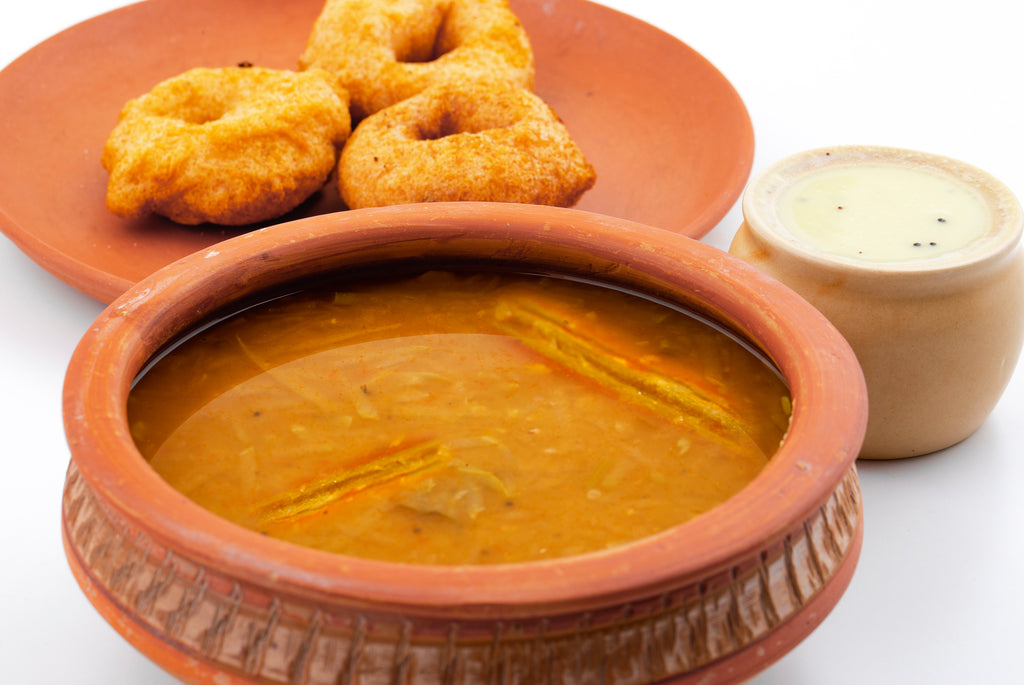
Sambar And The Maratha Link

By Ranjeni A Singh
The word ‘sambar’ conjures up an image of a bowl of spicy-tangy stew with soft idlis or crispy vadas dunked in it. Who doesn’t enjoy slurping these tasty dishes from southern India! To be precise, Tamil Nadu. But did you know that sambar has a Maharashtrian connection?
The story goes that the sambar we know today was created in the royal kitchen of Thanjavur, aka Tanjore, during the reign of the Marathas. Until the Nayaks were ousted from Thanjavur in 1674 by Shahuji Bhonsle, Shivaji’s cousin, the city was known for its art and temple architecture. Shahuji is believed to have been a culinary enthusiast and often experimented in the kitchen. Once while attempting to recreate the tangy Maharashtrian dish amti, Shahuji replaced moong dal (green gram) with arhar dal (pigeon peas) and kokum with tamarind. The king’s guest and Shivaji’s son, Sambhaji relished the dish so much that Shahuji decided to name the dish after Sambhaji. And sambar was born. Though some sambar fans contradict this, well-known food historian Pushpesh Pant says there are manuscripts at the Thanjavur Saraswati Mahal Library that support the story.
Over the years, many variants of sambar have come up, but the Thanjavur sambar is a league of its own. While Shahuji’s sambar was more a tamarind soup, the sambar prepared by Thanjavur’s cooks has no onion and garlic and is not very spicy. Other southern states have come up with their own variants of sambar. While in Karnataka, sambar is prepared with a wet paste as a base which is slightly sweet, the Tamil variant, which is made using dry sambar powder, is laden with vegetables such as drumstick, brinjal and ladyfinger.
Palakkad Iyers, who migrated from Tamil Nadu to Kerala, created their own variant of sambar. Called arachivita sambar, the key ingredient in the dish is coconut; fresh, grated coconut is roasted and ground to a paste along with fenugreek seeds, red chillies, coriander seeds, asafoetida, and split Bengal gram.
The taste of sambar depends a lot on the vegetables used. Usually home-cooked sambar consisted of only one vegetable; they could be either tomatoes, brinjal, pumpkin, ash gourd, onion, okra or drumsticks. Vegetables like cauliflower and lauki (bottle gourd) are not used as they tend to affect the aroma. Also, when using onion, asafoetida is avoided as they both have strong flavours and will clash.
Not many people outside Tamil Nadu know that sambar has two cousins — rasavangi and pitlai. Though they look similar, they taste different. The vegetables used are also different. In rasavangi, brinjal or ash gourd is used, while pitlai is made of okra. The main difference is that while in sambar, arhar dal is used, in rasavangi and pitlai, Bengal gram is used. The proportion of spices used is also different. In rasavangi and pitlai, the dominant flavours are that of coriander seeds and peppercorns. Both are of thicker consistency than sambar. Also, for arachivita sambar, coconut is not fried, whereas for rasavangi and pitlai, coconut is fried. Both are had with rice. They are not used as accompaniments for dosa, idlis or vadas.
All the three stews are packed with a host of health benefits. The pulses are rich source of protein; vegetables like brinjal, drumsticks, pumpkin, radish, and okra add to the fibre content; other ingredients like coriander seeds, fenugreek seeds, tamarind and curry leaves are rich in fibre, vitamins and minerals that aids digestion, weight loss, and immunity-enhancement, and the heat from the chillies help regulate body temperature during summers, keeping heat-related ailments away.
Ingredients required for making sambar are:
- Arhar dal
- Any vegetable(s) of choice (do not use cauliflower or bottle gourd)
- Tamarind
- Turmeric
- Asafoetida
- Sambar powder (dry roast 1/2 cup coriander seeds, one teaspoon of fenugreek, five red chillies and one tablespoon of split Bengal gram; roast the ingredients one by one; coconut is optional)
How To Make Sambar
Pressure cook half a cup of arhar dal and keep aside. The dal should be mushy and soft.
Boil chunks of one or more vegetables -- drumsticks, tomatoes, white radish, ash gourd, pumpkin – in a thick bottomed pan. Add half a teaspoon of asafoetida, half teaspoon of turmeric powder and salt to taste. Water should be enough so that all the vegetables are immersed.
Once the vegetables are cooked, add tamarind water (20 grams tamarind pulp mixed in one-an-half cups of water. Add two teaspoon heap of sambar power and cook again for five minutes.
Add the cooked dal. Add water to adjust consistency. The sambar should not be too thick or too thin. Boil sambar for one minute. Temper with mustard seeds and curry leaves. Serve with rice or dunk idlis and crispy vadas and enjoy a sumptuous meal.
